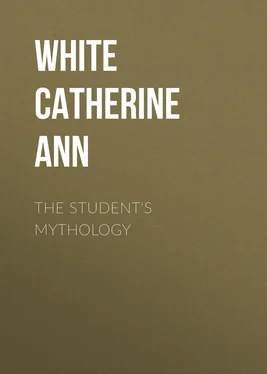Catherine White - The Student's Mythology
Здесь есть возможность читать онлайн «Catherine White - The Student's Mythology» — ознакомительный отрывок электронной книги совершенно бесплатно, а после прочтения отрывка купить полную версию. В некоторых случаях можно слушать аудио, скачать через торрент в формате fb2 и присутствует краткое содержание. Издательство: Иностранный паблик, Жанр: foreign_prose, foreign_religion, Философия, foreign_psychology, foreign_antique, на английском языке. Описание произведения, (предисловие) а так же отзывы посетителей доступны на портале библиотеки ЛибКат.
- Название:The Student's Mythology
- Автор:
- Издательство:Иностранный паблик
- Жанр:
- Год:неизвестен
- ISBN:нет данных
- Рейтинг книги:4 / 5. Голосов: 1
-
Избранное:Добавить в избранное
- Отзывы:
-
Ваша оценка:
- 80
- 1
- 2
- 3
- 4
- 5
The Student's Mythology: краткое содержание, описание и аннотация
Предлагаем к чтению аннотацию, описание, краткое содержание или предисловие (зависит от того, что написал сам автор книги «The Student's Mythology»). Если вы не нашли необходимую информацию о книге — напишите в комментариях, мы постараемся отыскать её.
The Student's Mythology — читать онлайн ознакомительный отрывок
Ниже представлен текст книги, разбитый по страницам. Система сохранения места последней прочитанной страницы, позволяет с удобством читать онлайн бесплатно книгу «The Student's Mythology», без необходимости каждый раз заново искать на чём Вы остановились. Поставьте закладку, и сможете в любой момент перейти на страницу, на которой закончили чтение.
Интервал:
Закладка:
Ques. Was there any foundation for such a belief?
Ans. It appeared quite certain that the sounds of which we have spoken, were really heard from this statue at sunrise; the only question is as to the means by which they were produced. The Colossus, although in a sitting posture, measures fifty-two feet in height, and the throne on which it rests is thirty feet long and eighteen broad. These dimensions were sufficient to admit of any internal machinery that might be required to produce the mysterious sounds. Such was the supposition of the Persian king Cambyses, who had the statue cleft asunder from the head to the middle of the body, but without discovering anything. Humboldt conjectured that the sound might be attributed to the nature of the stone, or to the action of the sun’s rays upon the air confined in the cavities of the statue. A much more reasonable solution of the mystery has been furnished by Mr. Wilkinson, an intelligent English traveller. He discovered in the lap of the statue a stone, which, on being struck, emits a metallic sound. There is a hollow space hewn in the block behind this stone, sufficiently large to admit of a person lying within it, entirely concealed from observation. Mr. Wilkinson tried the experiment, and was convinced that he had discovered the secret of this famous statue.
The face of the Memnon, like that of the Sphinx, has been mutilated by the Arabs; the positions of the figures which are yet uninjured show that the whole must have presented a beautiful and imposing appearance. The base of the throne is covered with ancient inscriptions in Greek and Latin, commemorating the visits of different illustrious persons, and testifying that they had heard the mysterious voice of Memnon.
CHAPTER XII
Ques. Who was Saturn?
Ans. He was the son of Cœlum and Terra. He was married to Ops, or Rhea, and was the father of Jupiter, Neptune and Pluto. As we have already learned, Saturn devoured the rest of his male children.
Ques. How is he represented?
Ans. Saturn is represented as an old man armed with a scythe, which signifies that time mows down everything in its course; and he holds in his hands an infant which he is about to devour, because time destroys all that it brings forth.
Ques. How did Saturn lose his kingdom?
Ans. He was deposed by Jupiter, and was obliged to take refuge in Italy, where he taught the people the arts of civilized life. Janus, king of Italy, made Saturn partner of his kingdom, and that part of the country was called Latium, from a Latin word which meant to hide; it was sometimes also called Saturnia. Saturn’s government was so wise and beneficial that his reign was called the Golden Age. The poets tell us that all men then lived on a perfect equality, property was held in common, and the earth brought forth its fruits without labor.
Ques. What sacrifices were offered to Saturn?
Ans. He was worshipped with human sacrifices, which seems strange when we consider that he was so mild a king. The planet Saturn was supposed by the ancients to exercise a malignant influence.
Ques. What were the Saturnalia?
Ans. They were solemnities instituted by Tullus Hostilius, king of Rome. In early times the festival lasted one day, but after Julius Cæsar, it was prolonged to three, four, or five days.
Ques. How were these days observed?
Ans. They were a season of general rejoicing; the Senate did not sit, schools gave holidays, and friends sent presents to one another. It was unlawful to proclaim war or execute criminals during this festival. Servants might, at this time, say what they pleased to their masters, who could not take offence; also, in memory of the freedom and equality enjoyed in Saturn’s reign, they sat at table while their masters served, and reproved the latter freely if they were guilty of any awkwardness. Lastly, servants and common people were allowed to wear purple cloaks, a distinction reserved at other times to the patricians. The Saturnalia is probably represented in some degree by the modern Carnival. Saturn is thought by some persons to have been the same as Noah.
Ques. Who was Janus?
Ans. He was an ancient Italian deity, of whose origin very contradictory accounts are given. He was supposed to have reigned in Italy in the time of Saturn, and to have associated that god with him in the kingdom. He was generally represented with two faces, and was called hence, Janus Bifrons. He had many temples in Rome. The gates of the chief temple, that of Janus Quiri´nus, were always open in time of war, and closed when the Romans were at peace. It is a remarkable circumstance that the gates of Janus were closed but three times in seven hundred years. They were shut for the first time in the reign of Numa; again, after the first Punic war; and Augustus closed the temple the third time when he had given peace to the world. This occurred just before the coming of our Lord. The first month of the year is named from Janus.
CHAPTER XIII
Ques. Who was Vulcan?
Ans. He was the son of Jupiter and Juno, but was cast down from heaven on account of his deformed appearance. He landed in Lemnos, but broke his leg in the fall, and remained lame ever afterwards.
Ques. How was Vulcan represented?
Ans. As a smith standing by an anvil with tools in his hand.
Ques. What was his occupation?
Ans. He had a blacksmith shop in Lemnos, where he manufactured Jupiter’s thunderbolts, and the arms of the other gods. Vulcan was the god of fire, and the patron of blacksmiths and armorers.
Ques. What were the most celebrated works of Vulcan?
Ans. The armor of Achil´les and of Æne´as, the beautiful necklace of Hermi´one, the crown of Ariadne, and the brazen palace of the sun. The shield of Achil´les was enamelled with metals of various colors, and embossed with beautiful historical designs.
Ques. To whom was Vulcan married?
Ans. Vulcan was married to Venus, but that goddess behaved treacherously towards him and attached herself to Mars.
Ques. Who were the servants of Vulcan?
Ans. The attendants of Vulcan were called Cyclops, because they had each one eye in the middle of the forehead; they were the offspring of Neptune and Amphitri´te.
Ques. How was Vulcan worshipped?
Ans. The Romans celebrated feasts in his honor called Vulcania. At these they sacrificed animals by throwing them into the fire to be burned to death. The Athenians also kept feasts of Vulcan, and there was in Sicily, upon Mount Etna, a famous temple dedicated to him.
Ques. What was peculiar about this temple?
Ans. The approach to it was guarded by dogs, whose scent was so keen that they could discover whether the persons coming to the temple were virtuous or wicked. To the servants of Vulcan might be added Cacus, who stole the oxen of Hercules; and the robber Cæ´culus, from whom the noble Roman family of the Cæcilii derived their name. He was the founder of the city of Præneste. One fable is, that certain shepherds found Cæ´culus, when an infant, lying unhurt in a glowing fire, from which circumstance he was supposed to be the son of Vulcan. The shepherd, Polyphemus, resembled the Cyclops, and was, like them, a son of Neptune. The monster devoured several of the companions of Ulysses, but the hero, having made him drunk with wine, put out his single eye with a firebrand and escaped. He embarked in haste, pursued by the monster; his companions shouted defiance as they weighed anchor, and the blind Cyclops, directed by the sound of their voices, hurled a rock into the sea, by which their vessel was almost swamped. Warned by this danger, they rowed silently until they reached the open sea. Some writers have imagined that the Cyclops were a race of miners, who, descending into the deep recesses of the earth, and coming forth again, had a lamp attached to their foreheads, to give them light. This, at a distance, would appear like a large, flaming eye, and might give rise to the fable of one-eyed monsters. This explanation is, however, far fetched and improbable.
Читать дальшеИнтервал:
Закладка:
Похожие книги на «The Student's Mythology»
Представляем Вашему вниманию похожие книги на «The Student's Mythology» списком для выбора. Мы отобрали схожую по названию и смыслу литературу в надежде предоставить читателям больше вариантов отыскать новые, интересные, ещё непрочитанные произведения.
Обсуждение, отзывы о книге «The Student's Mythology» и просто собственные мнения читателей. Оставьте ваши комментарии, напишите, что Вы думаете о произведении, его смысле или главных героях. Укажите что конкретно понравилось, а что нет, и почему Вы так считаете.












